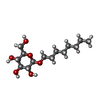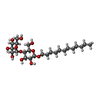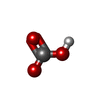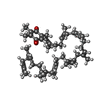[English] 日本語
 Yorodumi
Yorodumi- PDB-8r2i: Cryo-EM Structure of native Photosystem II assembly intermediate ... -
+ Open data
Open data
- Basic information
Basic information
| Entry | Database: PDB / ID: 8r2i | ||||||
|---|---|---|---|---|---|---|---|
| Title | Cryo-EM Structure of native Photosystem II assembly intermediate from Chlamydomonas reinhardtii | ||||||
 Components Components |
| ||||||
 Keywords Keywords | PHOTOSYNTHESIS / Photosystem II / biogenesis of PSII / assembly intermediate / CryoEM / assembly factor / Chlamydomonas reinhardtii | ||||||
| Function / homology |  Function and homology information Function and homology informationphotosystem II repair / chloroplast thylakoid lumen / photosystem II assembly / oxygen evolving activity / photosystem II reaction center / photosystem II / oxidoreductase activity, acting on diphenols and related substances as donors, oxygen as acceptor / photosynthetic electron transport chain / photosystem II / response to herbicide ...photosystem II repair / chloroplast thylakoid lumen / photosystem II assembly / oxygen evolving activity / photosystem II reaction center / photosystem II / oxidoreductase activity, acting on diphenols and related substances as donors, oxygen as acceptor / photosynthetic electron transport chain / photosystem II / response to herbicide / : / chlorophyll binding / photosynthetic electron transport in photosystem II / phosphate ion binding / chloroplast thylakoid membrane / photosynthesis / electron transfer activity / protein stabilization / iron ion binding / heme binding / metal ion binding Similarity search - Function | ||||||
| Biological species |  | ||||||
| Method | ELECTRON MICROSCOPY / single particle reconstruction / cryo EM / Resolution: 2.9 Å | ||||||
 Authors Authors | Fadeeva, M. / Klaiman, D. / Kandiah, E. / Nelson, N. | ||||||
| Funding support |  Israel, 1items Israel, 1items
| ||||||
 Citation Citation |  Journal: Front Plant Sci / Year: 2023 Journal: Front Plant Sci / Year: 2023Title: Structure of native photosystem II assembly intermediate from . Authors: Mariia Fadeeva / Daniel Klaiman / Eaazhisai Kandiah / Nathan Nelson /   Abstract: Photosystem II (PSII) is a dimer consisting of at least 13 nuclear-encoded and four chloroplast-encoded protein subunits that collectively function as a sunlight-driven oxidoreductase. In this ... Photosystem II (PSII) is a dimer consisting of at least 13 nuclear-encoded and four chloroplast-encoded protein subunits that collectively function as a sunlight-driven oxidoreductase. In this study, we present the inaugural structure of a green alga PSII assembly intermediate (pre-PSII-int). This intermediate was isolated from chloroplast membranes of the temperature-sensitive mutant TSP4, cultivated for 14 hours at a non-permissive temperature. The assembly state comprises a monomer containing subunits A, B, C, D, E, F, H, I, K, and two novel assembly factors, Psb1 and Psb2. Psb1 is identified as a novel transmembrane helix located adjacent to PsbE and PsbF (cytochrome b559). The absence of PsbJ, typically found in mature PSII close to this position, indicates that Psb1 functions as an assembly factor. Psb2 is an eukaryotic homolog of the cyanobacterial assembly factor Psb27. The presence of iron, coupled with the absence of Q, Q, and the manganese cluster, implies a protective mechanism against photodamage and provides insights into the intricate assembly process. | ||||||
| History |
|
- Structure visualization
Structure visualization
| Structure viewer | Molecule:  Molmil Molmil Jmol/JSmol Jmol/JSmol |
|---|
- Downloads & links
Downloads & links
- Download
Download
| PDBx/mmCIF format |  8r2i.cif.gz 8r2i.cif.gz | 467 KB | Display |  PDBx/mmCIF format PDBx/mmCIF format |
|---|---|---|---|---|
| PDB format |  pdb8r2i.ent.gz pdb8r2i.ent.gz | 341.7 KB | Display |  PDB format PDB format |
| PDBx/mmJSON format |  8r2i.json.gz 8r2i.json.gz | Tree view |  PDBx/mmJSON format PDBx/mmJSON format | |
| Others |  Other downloads Other downloads |
-Validation report
| Summary document |  8r2i_validation.pdf.gz 8r2i_validation.pdf.gz | 3.5 MB | Display |  wwPDB validaton report wwPDB validaton report |
|---|---|---|---|---|
| Full document |  8r2i_full_validation.pdf.gz 8r2i_full_validation.pdf.gz | 3.7 MB | Display | |
| Data in XML |  8r2i_validation.xml.gz 8r2i_validation.xml.gz | 103.3 KB | Display | |
| Data in CIF |  8r2i_validation.cif.gz 8r2i_validation.cif.gz | 135.3 KB | Display | |
| Arichive directory |  https://data.pdbj.org/pub/pdb/validation_reports/r2/8r2i https://data.pdbj.org/pub/pdb/validation_reports/r2/8r2i ftp://data.pdbj.org/pub/pdb/validation_reports/r2/8r2i ftp://data.pdbj.org/pub/pdb/validation_reports/r2/8r2i | HTTPS FTP |
-Related structure data
| Related structure data |  18848MC M: map data used to model this data C: citing same article ( |
|---|---|
| Similar structure data | Similarity search - Function & homology  F&H Search F&H Search |
- Links
Links
- Assembly
Assembly
| Deposited unit | 
|
|---|---|
| 1 |
|
- Components
Components
-Photosystem II ... , 8 types, 8 molecules ABCDHIK1
| #1: Protein | Mass: 36287.348 Da / Num. of mol.: 1 / Source method: isolated from a natural source / Source: (natural)  |
|---|---|
| #2: Protein | Mass: 53739.043 Da / Num. of mol.: 1 / Source method: isolated from a natural source / Source: (natural)  |
| #3: Protein | Mass: 46468.094 Da / Num. of mol.: 1 / Source method: isolated from a natural source / Source: (natural)  |
| #4: Protein | Mass: 39241.734 Da / Num. of mol.: 1 / Source method: isolated from a natural source / Source: (natural)  |
| #7: Protein | Mass: 7063.317 Da / Num. of mol.: 1 / Source method: isolated from a natural source / Source: (natural)  |
| #8: Protein/peptide | Mass: 3276.967 Da / Num. of mol.: 1 / Source method: isolated from a natural source / Source: (natural)  |
| #9: Protein/peptide | Mass: 4147.979 Da / Num. of mol.: 1 / Source method: isolated from a natural source / Source: (natural)  |
| #11: Protein/peptide | Mass: 3219.900 Da / Num. of mol.: 1 / Source method: isolated from a natural source / Source: (natural)  |
-Cytochrome b559 subunit ... , 2 types, 2 molecules EF
| #5: Protein | Mass: 8727.849 Da / Num. of mol.: 1 / Source method: isolated from a natural source / Source: (natural)  |
|---|---|
| #6: Protein/peptide | Mass: 3795.562 Da / Num. of mol.: 1 / Source method: isolated from a natural source / Source: (natural)  |
-Protein , 1 types, 1 molecules 2
| #10: Protein | Mass: 11213.722 Da / Num. of mol.: 1 / Source method: isolated from a natural source / Source: (natural)  |
|---|
-Sugars , 3 types, 6 molecules 




| #16: Sugar | | #18: Sugar | #20: Sugar | ChemComp-DGD / | |
|---|
-Non-polymers , 10 types, 57 molecules 


















| #12: Chemical | ChemComp-FE2 / | ||||||||||||||||
|---|---|---|---|---|---|---|---|---|---|---|---|---|---|---|---|---|---|
| #13: Chemical | ChemComp-CLA / #14: Chemical | #15: Chemical | ChemComp-BCR / #17: Chemical | #19: Chemical | ChemComp-LHG / | #21: Chemical | ChemComp-BCT / | #22: Chemical | ChemComp-PL9 / | #23: Chemical | ChemComp-HEM / | #24: Water | ChemComp-HOH / | |
-Details
| Has ligand of interest | N |
|---|
-Experimental details
-Experiment
| Experiment | Method: ELECTRON MICROSCOPY |
|---|---|
| EM experiment | Aggregation state: PARTICLE / 3D reconstruction method: single particle reconstruction |
- Sample preparation
Sample preparation
| Component | Name: Photosystem II assembly intermediate from Chlamydomonas reinhardtii Type: COMPLEX / Entity ID: #1-#9, #11, #10 / Source: NATURAL |
|---|---|
| Molecular weight | Units: KILODALTONS/NANOMETER / Experimental value: NO |
| Source (natural) | Organism:  |
| Buffer solution | pH: 6 |
| Specimen | Conc.: 0.5 mg/ml / Embedding applied: NO / Shadowing applied: NO / Staining applied: NO / Vitrification applied: YES |
| Specimen support | Grid material: COPPER / Grid mesh size: 300 divisions/in. / Grid type: Quantifoil R1.2/1.3 |
| Vitrification | Instrument: LEICA EM GP / Cryogen name: ETHANE / Humidity: 90 % / Chamber temperature: 293 K |
- Electron microscopy imaging
Electron microscopy imaging
| Experimental equipment |  Model: Titan Krios / Image courtesy: FEI Company |
|---|---|
| Microscopy | Model: FEI TITAN KRIOS |
| Electron gun | Electron source:  FIELD EMISSION GUN / Accelerating voltage: 300 kV / Illumination mode: FLOOD BEAM FIELD EMISSION GUN / Accelerating voltage: 300 kV / Illumination mode: FLOOD BEAM |
| Electron lens | Mode: BRIGHT FIELD / Nominal magnification: 105000 X / Nominal defocus max: 2200 nm / Nominal defocus min: 800 nm / Cs: 2.7 mm / C2 aperture diameter: 100 µm |
| Specimen holder | Cryogen: NITROGEN |
| Image recording | Average exposure time: 1.8 sec. / Electron dose: 1.07 e/Å2 / Film or detector model: GATAN K3 BIOQUANTUM (6k x 4k) / Num. of grids imaged: 3 / Num. of real images: 25758 |
- Processing
Processing
| EM software |
| ||||||||||||||||||||||||||||
|---|---|---|---|---|---|---|---|---|---|---|---|---|---|---|---|---|---|---|---|---|---|---|---|---|---|---|---|---|---|
| CTF correction | Type: NONE | ||||||||||||||||||||||||||||
| Particle selection | Num. of particles selected: 6408350 | ||||||||||||||||||||||||||||
| Symmetry | Point symmetry: C1 (asymmetric) | ||||||||||||||||||||||||||||
| 3D reconstruction | Resolution: 2.9 Å / Resolution method: FSC 0.143 CUT-OFF / Num. of particles: 327737 / Algorithm: FOURIER SPACE / Num. of class averages: 1 / Symmetry type: POINT | ||||||||||||||||||||||||||||
| Refinement | Cross valid method: NONE Stereochemistry target values: GeoStd + Monomer Library + CDL v1.2 | ||||||||||||||||||||||||||||
| Displacement parameters | Biso mean: 47.69 Å2 | ||||||||||||||||||||||||||||
| Refine LS restraints |
|
 Movie
Movie Controller
Controller


 PDBj
PDBj





















